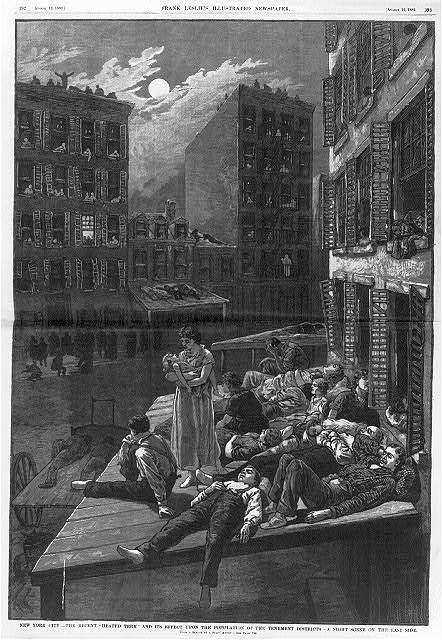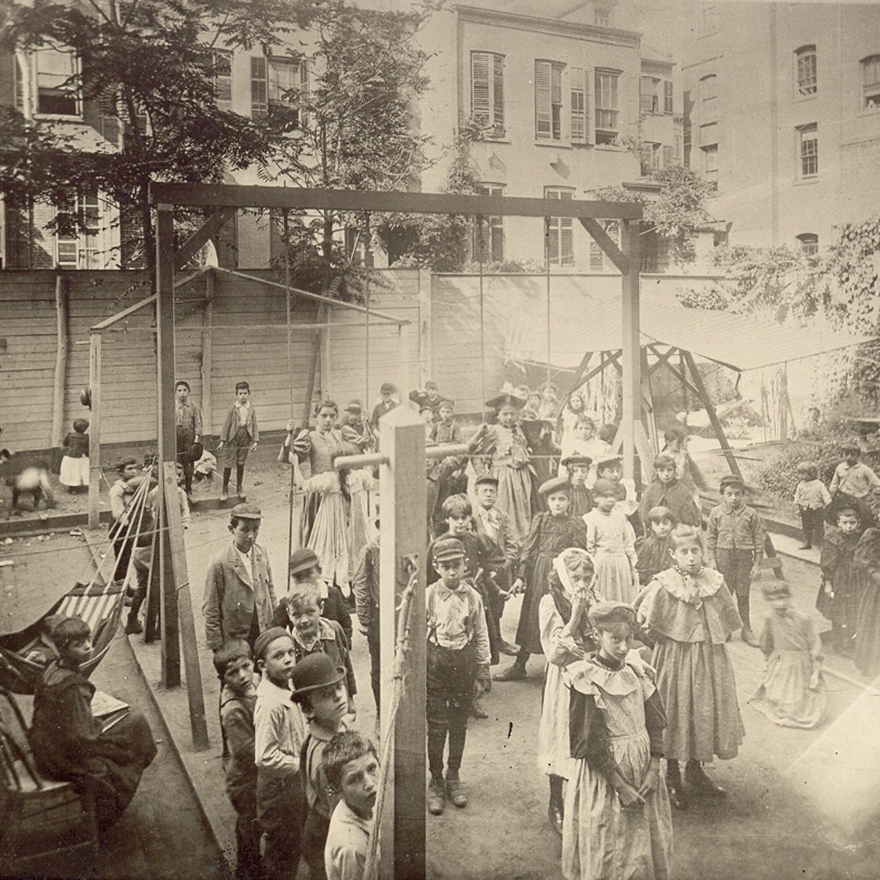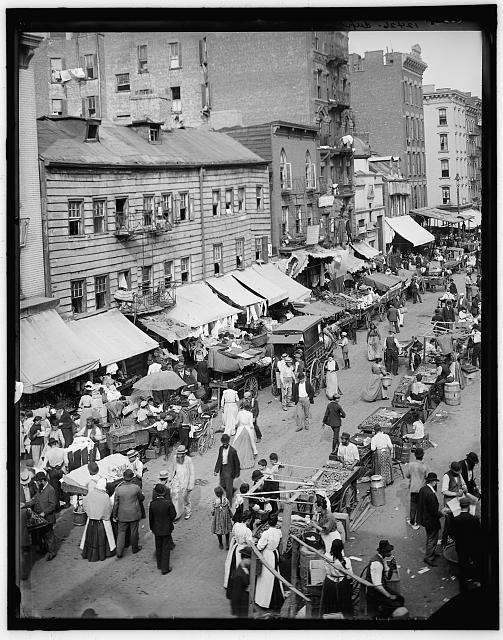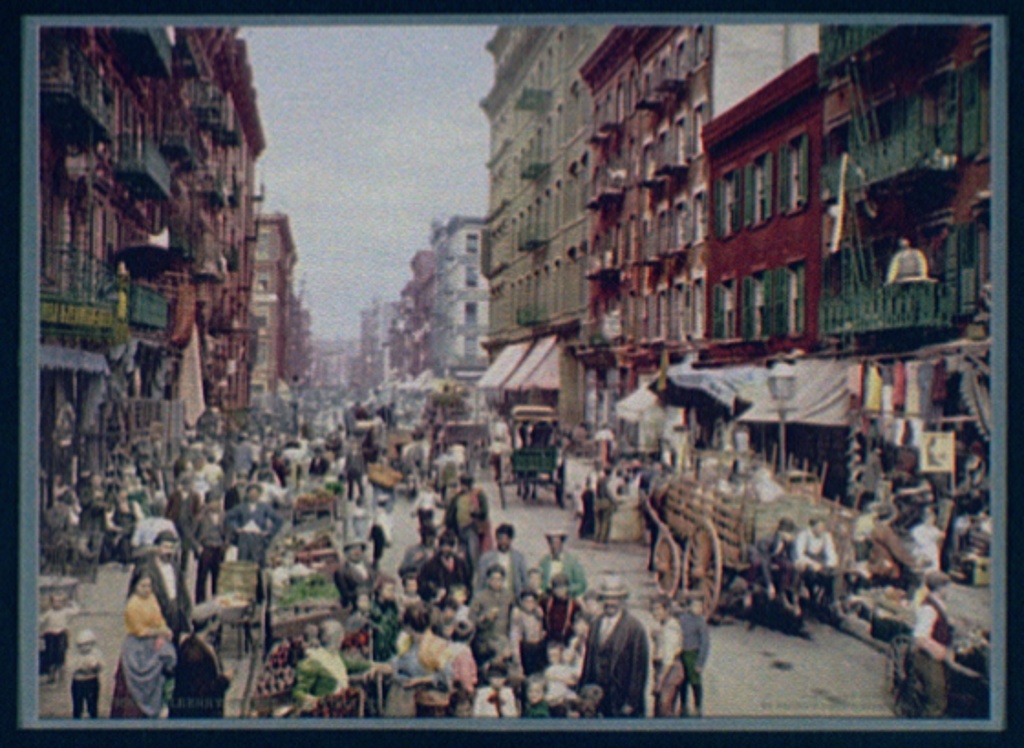By Anne M. Filiaci, Ph.D.
Wald believed that recreation was a human right, crucial to promoting public health and improving the quality of life. While she lived at Jefferson Street, she began to organize community parties and excursions in order to support the need for recreation. After moving to Henry Street, one of the ways she expanded these efforts was by building a playground in the space behind the Settlement.
" order_by="sortorder" order_direction="ASC" returns="included" maximum_entity_count="500"]Wald built the Henry Street Settlement playground—later described as the “Bunker Hill” of the playground movement—in response to a pressing need for public recreational spaces in her neighborhood. Adults and children crowded the city streets twenty-four hours a day, especially during the hot summers. On summer nights, mothers who had nowhere else to go sat “on curbstones with nursing babies” seeking the coolness of the stone as an escape from the built-up heat in their apartments.
During the day, many parents banished their children to the streets. Some who worked did not trust children home alone, while others did not want active youngsters underfoot in crowded tenement apartments. Parents who turned their homes into sweatshops often had no choice–they either put their children to work or sent them outside.
These “exiled” children flooded the streets, where normal childhood play was difficult if not impossible. Wald remembered that “In the midst of the pushcart market, with its noise, confusion and jostling,” children often attempted to play board games like checkers by resting boards precariously on the tops of fire hydrants—only to have them “constantly knocked over by the crowd.” The less sedate street “urchins” faced even greater risks. One “tearful small boy” lamented to Wald about how “first the ‘cop’ had snatched his dice, then…nobody wanted him to chalk on the sidewalk,” and then, to cap it all off, he was “arrested for throwing a ball.”
In addition to facing these obstacles to their ability to play—as well as the normal dangers posed by the traffic on crowded streets—street children mixed regularly with petty criminals and prostitutes. “[B]abies sat on the stoops,” Wald wrote, “playing with the business cards of the houses” of ill repute, while older children imitated the behavior of the women who “tried by a peculiar hissing noise to draw the attention of the men.”
Remembering her idyllic childhood—replete with dolls and games and backyard playhouses—Wald was determined to bring similar experiences to the children in her neighborhood. She had seen the potential of the yard at the Henry Street house from the start. “Attractive as we found the house,” she wrote, “we were even more excited over the possibilities of the little back yard.”
Soon after moving in, Wald went to work, converting the “yard and one belonging to an adjacent school, with, later, the yard of a third house rented by one of our residents, into a miniature but very complete playground.” “Along the borders” of the yard, the Settlement’s residents “planted bright-colored flowers.” More flowers bloomed in window boxes that “jutted from the rear windows of the two houses controlled by the settlement.” An “old wisteria vine on a trellis covered nearly a third of the playground,” and “two ailanthus trees” provided shade.” Under an awning in the corner they built a sand pile and erected swings (which the children called “scups”) and gymnastic equipment, including parallel bars and an overhead ladder.
The Settlement used its backyard playground for different purposes throughout the day. During mornings it was the site of an informal kindergarten. In the early afternoon, they held “directed play and taught the use of gymnastic equipment. Later on, “mothers and older children came, and a little hurdy-gurdy occasionally marked the rhythm of the dance.” A man from Sailors’ Snug Harbor (a retirement community for aged seamen) worked at a stretching frame, demonstrating how to make hammocks. The parents and older children used the finished hammocks to swing babies.
In the evenings, the Settlement workers put away the baby hammocks and chairs, illuminated Japanese lanterns, and transformed the playground into a place where young adults could dance and sing and socialize after a hard day’s work. During these “evening parties,” Wald, along with other settlement residents, sat on a bench “gowned in white,” awaiting “their guests.” Once, when she “rose from the bench…to cross the yard” in order to welcome them, Wald heard a young printer say with enthusiasm, “This must be like the scenes of country life in English novels.”
- The Henry Street playground was usually filled to capacity, with lines of people waiting to get in. Young people crowded the sidewalks outside; many tried to figure out ways to jump the line. “[C]hildren soon learned,” Wald recalled, “that ‘little mothers’ and their charges had precedence, and there was rivalry as to who should hold the family baby. When (as rarely happened) there was none in the family, a baby was borrowed.” Wald tried to make the playground as free from restrictions as possible, although there was one rule to which she demanded strict adherence: “that the girls who used the ‘scups’ (swings) must wear panties or diapers.”
The Henry Street playground was long remembered by grateful children. Decades later Wald received “letters from men and women who try to recall themselves to my memory by saying that they had once played in our back yard.”
Bibliography
Daniels, Doris Groshen, Always a Sister: The Feminism of Lillian D. Wald, New York, Feminist Press, 1989.
Davis, Allen F., Spearheads for Reform: The Social Settlements and the Progressive Movement, 1890-1914, New York, Oxford University Press, 1967.
Duffus, R.L., Lillian Wald: Neighbor and Crusader, New York: The Macmillan Company, 1939.
[Epstein], Beryl Williams, Lillian Wald: Angel of Henry Street [author’s name appears on title page as “Beryl Williams”], NY: Julian Messner, Inc., 1948.
Wald, Lillian D., The House on Henry Street, N:Y: Henry Holt & Co., 1915.
Wald, Lillian, Lillian Wald Papers, New York : New York Public Library, [1983]. (LDW to Abbot E. Kittredge, Oct. 29, 1903.)
Wald, Lillian D., Windows on Henry Street, Boston: Little Brown, and Company, 1934.
Illustrations
Playground of the Henry Street Settlement http://povertyhistory.org/browse#henry-street-settlement/henry-street-playground_880 [ca. 1895] Current 4/27/16
Henry Street Settlement Playground (same photo as above) https://www.flickr.com/photos/unhny/5926733195 [ca. 1895] Current 4/27/16
Library of Congress, Mulberry Street, New York City, Digital ID: (digital file from intermediary roll film) det 4a31829 http://hdl.loc.gov/loc.pnp/det.4a31829, Reproduction Number: LC-USZC4-1584 (color film copy transparency) LC-USZC4-4637 (color film copy transparency) LC-USZCN4-45 (color film copy neg.), Repository: Library of Congress Prints and Photographs Division Washington, D.C. 20540 USA (ca. 1900) http://loc.gov/pictures/resource/det.4a31829/ Current 4/27/16
LOC, Title: New York City – The recent “heated term” and its effect upon the population of the tenement districts A night scene on the East Side / / from sketch by a staff artist.
Date Created/Published: 1882 Aug. 12. Medium: 1 print : wood engraving. Summary: Tenement dwellers sleeping on roofs and windowsills.
Reproduction Number: LC-USZ62-75193 (b&w film copy neg.)
Call Number: Illus. in AP2.L52 Case Y [P&P] Notes: Illus. in: Frank Leslie’s illustrated newspaper, Aug. 12, 1882, p. 393. http://www.loc.gov/pictures/resource/cph.3b22428/ Current 4/27/16
LOC, Title: [Jewish market on the East Side, New York, N.Y.] Related Names: Detroit Publishing Co. , publisher. Date Created/Published: [between 1890 and 1901]
Medium: 1 negative : glass ; 8 x 10 in. Reproduction Number: LC-D401-12426 (b&w film copy neg.) LC-DIG-det-4a07950 (digital file from original) Rights Advisory: No known restrictions on publication. Call Number: LC-D4-12426 <P&P> [P&P]
Repository: Library of Congress Prints and Photographs Division Washington, D.C. 20540 USA Notes: Title and date from Detroit, Catalogue J (1901). “Dup” on negative. Detroit Publishing Co. no. 012426. Gift; State Historical Society of Colorado; 1949. http://www.loc.gov/pictures/resource/det.4a07950/ Current 4/27/16
Copyright Anne M. Filiaci 2016



